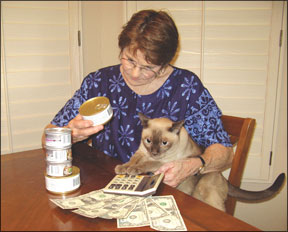Its no secret that gas prices are on the rise. So is just about everything else, including pet food. The U.S. Bureau of Labors Consumer Price Index reports that pet food prices for the second quarter of 2008 rose by eight to nine percent. While thats not as much of an increase as milk or gasoline, consumers are still seeing the most significant price increase in pet food in years. What gives?

Bev Caldwell
288
“If you look at the rising cost of pet foods, its all because of the cost of grains,” says Joseph Wakshlag, DVM, PhD, assistant professor of Clinical Nutrition at Cornell Universitys College of Veterinary Medicine. “All of the grains such as corn and rice that are used to make pet food have gone up in price, so pet food prices had to rise as well. And that cost has to be passed on to the consumer.”
Pet owners like Teri Grohl have noticed. Grohl, an administrative assistant for a high-tech company, spent a portion of her $600 stimulus check on food and cat litter for her three cats, ages 12, six and two.
“Cat food is definitely getting more expensive,” says Grohl, who was in a family-owned pet store in Calabasas, CA, recently to buy cat food, litter and a bag of gourmet treats for her four-legged family. “My cats are my best friends, though, and if I have to get a part-time job delivering pizzas to pay for their food and medical care, thats what Ill do.”
Grohl says that she is paying about 15 percent more on cat food than she was a year ago. This jump in price is partly attributed to the fact that Grohl is now buying a veterinarian-prescribed cat food for her eldest cat, Sadie, who has kidney disease.
“The [kidney diet] food is definitely more costly compared to the food I buy for my other two cats, but its helped Sadie stay healthier,” Grohl says. “Without the higher-priced food, her kidneys would be in much worse shape.”
Dr. Wakshlag estimates that consumers are paying, on average, $.80 to $1.00 more for low-end pet foods, which can be purchased at grocery and big box stores, and $2 to $3 more for the high-end pet foods, which are available from veterinary clinics and specialty stores. But, Dr. Wakshlag points out, not all high-end cat food is worth the hefty price tag.
“A more expensive brand of cat food will sometimes have more digestible ingredients,” he says, “but thats not always the case. There are some really high-end foods out there that have some pretty poor choices as far as grains go. It really comes down to going with a product that has worked well for your cat for a long time.”
And what about owners who think theyll save money by cooking for their cats? According to Dr. Wakshlag, preparing home-cooked meals is not only more expensive than serving a commercially prepared cat food, but its time-consuming as well. “If you want to do it right,” he says, “you would need to start with a quality food like chicken breast, and then add in a rice or grain source, some oils and fats, a multi-vitamin, calcium, taurine, perhaps a B12 supplement – all the things that would make the home-cooked food equivalent to a commercially-prepared cat food, which is formulated to be complete and balanced nutrition.
All of a sudden, you find that youre paying three times as much, per pound, for all the ingredients as the same amount of a commercial cat food. The best bargain is still commercial cat food.”
Nationally, higher pet food prices are just one more indicator of the slowing economys impact on cats and their families. In June, the Humane Society of the United States (HSUS) (www.hsus.org/foreclosurepets) began offering grants to animal shelters and rescue organizations to aid pet owners facing home foreclosures and financial problems.
“Dealing with a financial crisis is scary enough,” Stephanie Shain, director of outreach for Companion Animals at the HSUS, said on the organizations Web site. “We hope to ease the burden in some way for families by helping their local shelter help them keep their pet home and part of the family.” The American Humane Association (www.americanhumane.org) and United Animal Nations (www.uan.org) also have begun offering grants to assist pet owners who are at risk of losing their pets due to skyrocketing costs. All three organizations welcome donations from individuals who are in a position to help others less fortunate than themselves; visit the Web sites listed above for more information.
Meanwhile, Terri Grohl put another bag of cat food in her shopping cart and headed to the checkout counter. “The larger bag offers more of a cost savings than the smaller bag,” Grohl notes. “Plus, I dont have time to cook for my cats.”

